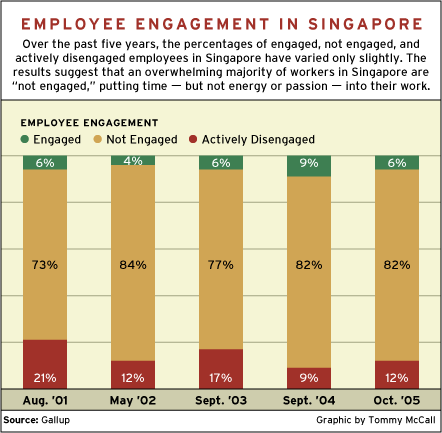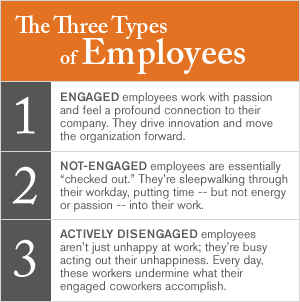The percentage of disenchanted employees in Singapore increased somewhat last year, and the trend should be a cause of continuing concern for the country's business and government leaders.
Each year since 2001, Gallup has surveyed workers in Singapore to gauge their perceptions about their workplace and their lives in general. Results from the most recent survey show that the percentage of "actively disengaged" employees increased from 9% in 2004 to 12% in 2005, while the percentage of "engaged" employees declined slightly (9% in 2004 to 6% in 2005). (See graphics "The Three Types of Employees" and "Employee Engagement in Singapore.")
During the past four years, the percentage of engaged employees has remained consistently low, ranging from 4% in 2002 to 9% in 2004. The percentage of actively disengaged employees has been relatively high, ranging from a low of 9% in 2004 to a high of 17% in 2001 and 2003. These findings suggest a serious problem, given that in today's competitive world, companies and countries are very dependent on an engaged workforce for their success. Gallup estimates that actively disengaged employees cost the Singapore economy about $6 billion in lost productivity.
Engaged employees, on the other hand, are not just more productive, they are also much more positive. The recent study found that employees who are more engaged take greater pride in the companies they work for, are more likely to build their careers within their companies, are happier with their compensation, and have more fun at work.
 |
What makes engaged employees tick?
Creating a more successful and engaged workforce in Singapore has been a much-discussed topic at various forums. Both public- and private-sector organizations are investigating employee engagement and its benefits. These organizations realize that even with its success over the past four decades, a small nation -- especially one strapped for national resources like Singapore -- can be vulnerable to competition from Hong Kong, Shanghai, and even Dubai if its workforce is not vibrant and engaged. Companies have also focused a great deal of attention on issues such as employee development, retraining, and work-life balance. While these are important matters -- and they do have some bearing on employee engagement levels -- other, more fundamental issues might be affecting worker engagement, and as a result, worker performance.
Gallup research shows that within companies, employee engagement can vary widely from workgroup to workgroup, in large part because managers have a tremendous influence on worker engagement. Through its research, Gallup has identified 12 key employee expectations that form the foundation of strong feelings of engagement. Managers and companies that want to promote employee engagement need to pay particular attention to these 12 employee needs, which include:
- Role clarity: Employees know what is expected of them at work.
- Resource availability: Employees have the tools they need to do their jobs right.
- Talent utilization: Workers have opportunities to use their talents in their roles every day.
- Recognition: Employees receive recognition regularly and feel cared for.
- Communication: Workers receive ongoing feedback on their performance and have regularly scheduled progress discussions.
- Bonding: Employees have strong bonds with their coworkers.
- Development: Employees have opportunities to learn and grow.
These are reasonable expectations for employees to have of their managers, coworkers, or workplace. Addressing these expectations, however, requires managers to work one-on-one with their employees, because individual needs and aspirations are different.
For example, it is safe to assume that all employees like to receive recognition when they do something well. Their preference for how they receive that recognition, though, varies widely. Some employees like public recognition, while others loathe it. Some like being recognized by their manager; others find praise from customers much more meaningful.
 |
Employees have equally different needs and expectations for role clarity, resources, talent utilization, communication, relationships, and development. The best companies and managers understand that people are unique and need to be managed as individuals.
Gallup's research in Singapore and elsewhere in Asia shows that there's still much work to be done before companies can fully capitalize on each employee's potential. If we look beyond this survey and examine the research that Gallup has done with companies across Asia, a telling reality emerges: Very few employees working in Asia today can strongly agree that their companies are meeting their needs on any of the engagement-related expectations mentioned above. Far too many workers struggle with unclear expectations of them, or lack the resources to do their jobs, or feel their current roles don't give them the opportunity to use their talents to the fullest at work.
Gallup's September 2005 poll of workers in Singapore shows that they face similar challenges in their workplaces. Before employee engagement can improve, companies in Singapore must look closely at the ways in which they manage their employees, day in and day out.
What are companies to do?
Gallup's research has shown that leaders and managers play a key role in lifting engagement levels. This statistic appears to reveal how leadership and management are perceived in Singapore: 62% of the respondents said that their supervisor treats them like a boss, while 38% said that their supervisor treats them like a partner. Why is this significant? The survey findings indicate that engagement is doubled, and disengagement is halved, when the respondent is treated as a partner rather than as a subordinate.
Employee engagement in Singapore is not dire, but it needs prompt and systematic attention. The survey shows the clear need for companies to take workforce engagement levels seriously, as the engagement of its employees may dictate the success or failure of businesses in times to come. What's more, leaders, managers, and employees must recognize that building engagement among the 1.7 million employees in the Singapore workforce must happen within each company, irrespective of the company type.
Action, and hence success, must start at the local level, workgroup by workgroup -- and manager by manager. Management styles should be aimed at motivating employees by capitalizing and building on employee talents, by recognizing their efforts, and by providing regular feedback on performance.
Results of this survey are based on a nationally representative sample of 1,006 Singaporean citizens and permanent residents between the ages of 18 and 54 who are currently employed full- or part-time. This Gallup Poll was conducted by telephone during October 2005. For results based on samples of this size, one can say with 95% confidence that the error attributable to sampling and other random effects could be ±3 percentage points. For findings based on sub-groups, the sampling error would be greater.